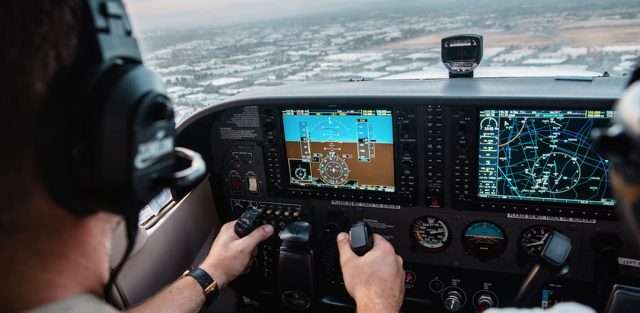NAVIGATION

The two rules of navigating aircraft:
Aircraft can be flown under two sets of rules, Visual Flight Rules (VFR) or Instrument Flight Rules (IFR), both of which affect navigation. Depending on weather conditions, a pilot may opt for one set of rules over the other. While Part 135 of the Federal Aviation Regulations allows for the use of VFR for air charter operators and private pilots for hire, Stratos Jets also requires its operators to follow IFR. Under VFR, the skies need to be clear so that a pilot can see outside the cockpit, control the aircraft's altitude, navigate, and avoid obstacles and other aircraft. A pilot will normally navigate using "dead reckoning" and visual observations, with reference to appropriate maps. This may be supplemented using radio navigation aids. An aircraft with navigational equipment is required for IFR, as a pilot will navigate the plane exclusively using radio and in some cases, satellite, navigation aids. IFR usually takes place within controlled airspace and normally requires filing a flight plan ahead of time. Established routes have to be used and the altitude is determined by such things as minimum airway altitude, minimum radar vectoring altitude (MRVA) and traffic situation.Air navigation follows the same principal points as all other navigation, in that it is the process of recording, planning and controlling the movement of an aircraft or vehicle from one point to another. Both commercial and private pilots for hire adhere to certain guidelines and rules.
Aircraft tend to fly faster, cannot stop mid-air, and also need to land in order to refuel, which can affect its navigation.
The two rules of navigating aircraft:
Aircraft can be flown under two sets of rules, Visual Flight Rules (VFR) or Instrument Flight Rules (IFR), both of which affect navigation. Depending on weather conditions, a pilot may opt for one set of rules over the other.
While Part 135 of the Federal Aviation Regulations allows for the use of VFR for air charter operators and private pilots for hire, Stratos Jets also requires its operators to follow IFR.
Under VFR, the skies need to be clear so that a pilot can see outside the cockpit, control the aircraft’s altitude, navigate, and avoid obstacles and other aircraft. A pilot will normally navigate using “dead reckoning” and visual observations, with reference to appropriate maps. This may be supplemented using radio navigation aids.
An aircraft with navigational equipment is required for IFR, as a pilot will navigate the plane exclusively using radio and in some cases, satellite, navigation aids. IFR usually takes place within controlled airspace and normally requires filing a flight plan ahead of time. Established routes have to be used and the altitude is determined by such things as minimum airway altitude, minimum radar vectoring altitude (MRVA) and traffic situation.








